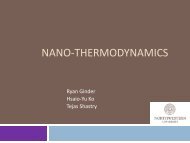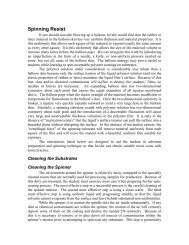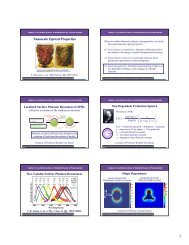A Practical Guide to SPM
A Practical Guide to SPM
A Practical Guide to SPM
You also want an ePaper? Increase the reach of your titles
YUMPU automatically turns print PDFs into web optimized ePapers that Google loves.
14<br />
Conductive AFM<br />
Conductive a<strong>to</strong>mic force microscopy (CAFM) is a secondary imaging<br />
mode derived from contact AFM that characterizes conductivity<br />
variations across medium- <strong>to</strong> low-conducting and semiconducting<br />
materials. CAFM performs general-purpose measurements and has a<br />
current range of pA <strong>to</strong> µA.<br />
Figure 5-7. Conductive AFM.<br />
CAFM employs a conductive probe tip. Typically, a DC bias is<br />
applied <strong>to</strong> the tip and the sample is held at ground potential. While<br />
the Z feedback signal is used <strong>to</strong> generate a normal contact AFM<br />
<strong>to</strong>pography image, the current passing between the tip and sample is<br />
measured <strong>to</strong> generate the conductive AFM image (Figure 5-7).<br />
Alternatively, using a second feedback loop, the applied voltage is<br />
modified <strong>to</strong> yield a constant current. It is the voltage data that<br />
constitutes the image.<br />
Tunneling AFM (TUNA)<br />
Tunneling AFM (TUNA) works similarly <strong>to</strong> conductive AFM, but with<br />
higher sensitivities. TUNA characterizes ultra-low currents (between<br />
80fA and 120pA) through the thickness of thin films. The TUNA<br />
application can be operated in either imaging or spectroscopy mode<br />
(see the Non-imaging Modes chapter). Applications include gate<br />
dielectric development in the semiconduc<strong>to</strong>r industry.<br />
Electric Force Microscopy<br />
Electric force microscopy (EFM) is a secondary imaging mode derived<br />
from TappingMode that measures electric field gradient distribution<br />
above the sample surface. The measurement is performed via<br />
LiftMode, a patented two-pass technique mentioned earlier in this<br />
chapter. LiftMode separately measures <strong>to</strong>pography and another<br />
selected property (magnetic force, electric force, etc.) using the<br />
<strong>to</strong>pographical information <strong>to</strong> track the probe tip at a constant height<br />
above the sample surface during the second pass.<br />
Figure 5-8. Electric force microscopy.<br />
Often, a voltage is applied between the tip and the sample in EFM.<br />
(Sometimes this voltage is not required <strong>to</strong> obtain an EFM image.) The<br />
cantilever’s resonance frequency and phase both change with the<br />
strength of the electric field gradient and are used <strong>to</strong> construct the EFM<br />
image. Locally charged domains on the sample surface are mapped<br />
in a manner similar <strong>to</strong> the way in which MFM maps magnetic domains<br />
(Figure 5-8).<br />
Surface Potential Imaging<br />
Surface potential (SP) imaging is a secondary imaging mode derived<br />
from TappingMode that maps the variation of the electrostatic potential<br />
across the sample surface. SP imaging is a nulling technique. As the<br />
tip travels above the surface in LiftMode (see the preceding section on<br />
EFM), the tip and the cantilever experience a force wherever the
















